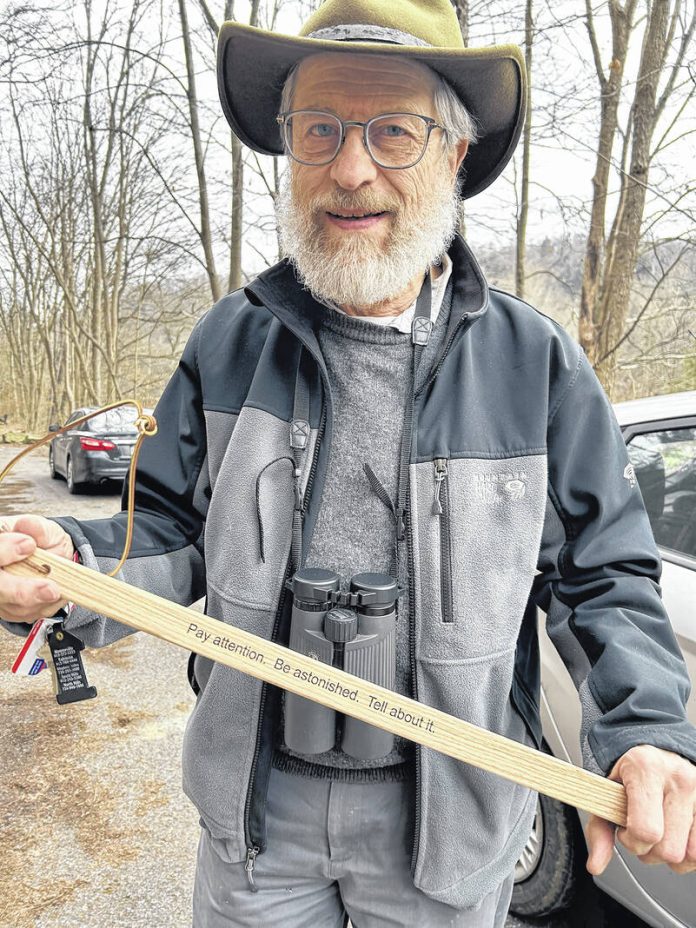PITTSBURGH — Charles Bier was the kid with snakes in his pockets.
Suburban environs can be dull. Lawns and roads don’t offer much biodiversity for curious boys. But Bier, the recently retired senior director of conservation science for the Western Pennsylvania Conservancy, found a way outside.
He caught salamanders and crayfish in Powers Run and fished at its confluence with the Allegheny River not too far from his O’Hara home. He scoured the Powers Run valley, heading to the orchards, forest and fields around the old Allegheny County Workhouse farm, now RIDC Park, where wildlife aplenty awaited.
After one of Bier’s captured black snakes got loose in the house, his mother banned the wild reptiles. But Bier’s outdoor forays persisted, as did the souvenirs.
He once stashed six snakes, including smooth green snakes (a slender non-venomous species), in an empty pop can that he hid under his mother’s car seat while returning from a family vacation in Erie.
Bier’s passion for nature paid off.
As an adult, he went on to survey every county in Western Pennsylvania and document the rarest creatures and plants. He served as director of the Pennsylvania Natural Heritage Program, which conducts much of the fieldwork used in designating endangered species and their conservation.
“Everyone can be a naturalist at some level,” said Bier, 69, of Buffalo Township. “People can be in better touch with nature. It’s like the moment when you look at the stars and realize there’s something bigger than you and Netflix.”
Bier’s fieldwork and recommendations led to the conservancy preserving more than 153,000 acres of species-rich land in Western Pennsylvania during his almost 43-year tenure, according to Cynthia Carrow, the conservancy’s vice president for government and community relations.
“It’s not often that somebody can say one’s work will be appreciated in the future for all people, for all time. That is quite a legacy,” she said.
Fungi and polar bears
Bier is still picking up wildlife, but he’s not putting it in his pockets.
Recently, while walking the Butler-Freeport Community Trail near his home, he scooped up and briefly cradled a leopard moth caterpillar crawling in the middle of the trail — a potential death sentence for the fuzzy black 1 1/2 -inch creature.
But Bier, being Bier, immediately spotted it and moved it to safety off the path in the hemlock-lined valley.
He knows what lives in the woods — things most people don’t see or consider. Things like fungi.
“If the mushroom isn’t on our pizza, we don’t think about it much,” he said.
But there are thousands of species of fungi in Pennsylvania.
“They’re not animals. They’re not plants,” Bier said. “They belong to another kingdom of organisms.
“What if the fungi went away? They are doing a lot of the decomposition work on earth. Imagine a tree falling and it doesn’t go away.”
There is much more to nature than what Bier calls the “mega charismatic vertebrates” — handsome wildlife like bears, squirrels, owls, bald eagles and river otters.
“The polar bear is loved,” he noted. “Films showing polar bears swimming in the ocean (without land in sight) tug at the heartstrings of the public.”
Macro charismatic vertebrates are attractive, but there’s so much more.
“What people consider to be lesser creatures such as fungi and insects are driving the ecosystem,” he said.
And they are interesting to see and learn about.
“Be fascinated,” Bier said. “Butterfly watching — they are just as fascinating as the bald eagles.”
There’s the general public’s “green blindness” to plant diversity.
“When you drive down the highway, if you’re not a naturalist, it’s just green stuff going by the window,” he said.
Then there are the myths about the dangers of snakes, bats and spiders. “People don’t have to be afraid. I’ve been around a lot of rattlesnakes and really haven’t been afraid.”
Bier’s lifelong work has focused on preserving the habitats of all life forms and some of the most endangered creatures on earth, including aquatic species.
Bier documented rarities such as multiple mussel species that are globally significant in French Creek and the Allegheny River.
The conservancy and other organizations continue to preserve land in the French Creek watershed.







